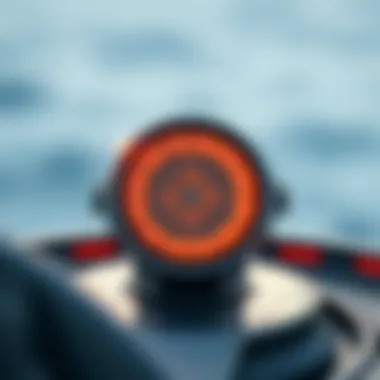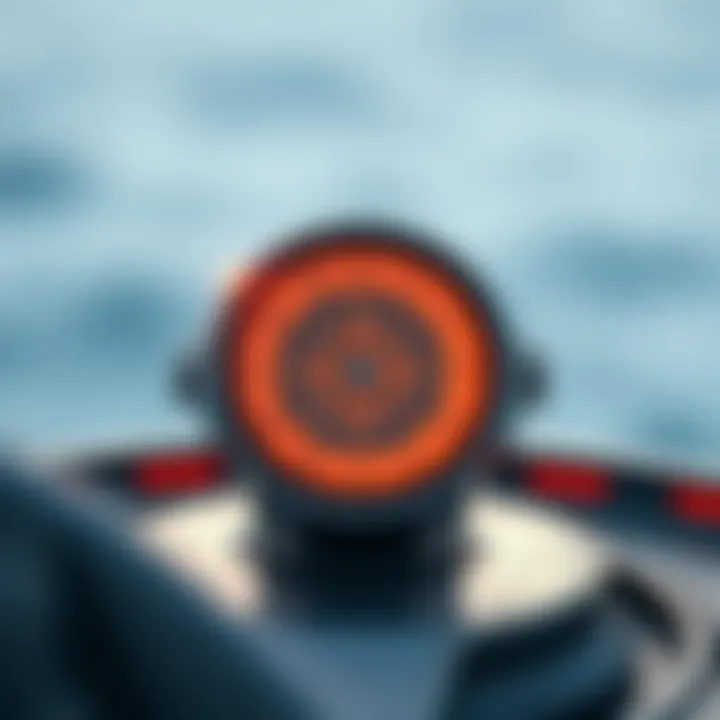Thor Compass Issues: Understanding Challenges and Solutions


Intro
In the intricate world of navigation, the Thor compass holds a distinct place, yet it is not without its challenges. This article aims to dissect various issues that users encounter, whether they are adventurers navigating through wilderness or professionals charting maritime routes. Understanding the underlying technical problems and user frustrations can empower both potential users and industry experts alike. By the end of this piece, you will have a deeper perspective on how to troubleshoot these devices effectively and stay ahead of potential pitfalls.
Technological advances have significantly transformed compasses over the years. However, even the best tools can have their fair share of hiccups. With this examination, we will explore not just the mechanics of the Thor compass but also real-world user experiences that shed light on the functionality—or sometimes lack thereof—of these devices.
The journey begins with an analysis of performance metrics. It is crucial to gauge how these compasses perform under different conditions and what implications arise when they do not function as advertised.
Understanding Thor Compasses
When discussing navigation tools, the Thor compass stands out as a significant instrument. Understanding the nuances of Thor compasses is crucial for anyone seriously interested in navigation, whether for recreational use or professional application. It goes beyond just knowing how to point the device north; comprehending its mechanics and operations opens a gate to better navigation practices.
Fundamentals of Compass Technology
A compass works fundamentally on the principle of magnetism. At its core, it utilizes the Earth’s magnetic field to detect directions. Traditional compasses often rely on a magnetic needle that aligns itself with magnetic north, but the evolution of technology has introduced enhancements in precision and functionality.
Thor compasses, for instance, may incorporate electronic sensors and advanced algorithms that significantly improve accuracy over their analog counterparts. By measuring subtle variations in the magnetic field, these compasses can provide real-time data about one’s heading, offering a distinct edge in navigation. This knowledge of the underlying technology empowers the user, making them more adept at troubleshooting and utilizing the compass effectively.
Design Features of Thor Compasses
The design of Thor compasses has evolved to meet the varied needs of its users. These compasses often have a robust outer casing, ensuring durability in rugged conditions, which is vital for outdoor enthusiasts and professionals alike. A user-friendly interface, complete with backlit displays and intuitive controls, stands out among their features. Additionally, many Thor compasses incorporate features like GPS integration, making them a one-stop solution for navigation needs.
An interesting aspect of these compasses is their emergency function capabilities, which can help guide users in critical situations. Knowing the layout of the device and its various features can mean the difference between a smooth journey and a serious misadventure.
Applications of Thor Compasses
Thor compasses find a plethora of applications, extending from recreational hikers to advanced maritime navigation. Enthusiasts enjoy their reliability while trekking through rugged terrains, where traditional GPS signals might falter. In maritime environments, sailors rely on accurate bearings offered by these compasses to avoid hazards and steer clear of trouble.
Moreover, Thor compasses can also serve in extreme situations such as search and rescue operations, where every second counts. Their precise functionality can guide rescuers to those in need swiftly and accurately. Even in air travel, pilots benefit from the navigational aids provided by electronic compasses, showcasing the versatility and importance of Thor compasses across various fields.
In summary, understanding Thor compasses encapsulates a wide array of factors—from the principles of compass technology to their sophisticated design features and multifaceted applications. This comprehensive knowledge equips users with the skills needed to navigate not only challenging terrains but also the complexities that come with modern navigation tools.
Identifying Common Problems
Identifying common problems related to the Thor compass is crucial for an informed and effective navigation experience. Many users often overlook the significance of these issues until they find themselves in a tricky spot or have a completely inaccurate reading. Seamless operation of a compass can be a matter of life or death, especially in remote locations. By digging into the various common problems, users can not only enhance their navigation competency but also extend the life of the equipment itself. Recognizing these issues can save time and resources in both professional and recreational scenarios, making it a fundamental focal point of this examination.
Calibration Issues
Calibration is the backbone of any compass in providing precise directions. Yet, calibration issues are far too frequent, leaving users frustrated. Proper calibration ensures that the compass reflects the correct magnetic north and not some misguided variation. Over time, factors like extreme weather conditions, physical impacts, or even manufacturing errors can throw a compass off-kilter.
One effective way to calibrate a Thor compass is through a systematic process that involves:
- Flat Surface: Placing the compass on a flat surface clears away any extraneous influences.
- Rotational Movement: Slowly rotating the compass in a horizontal plane can help recalibrate the internal mechanisms, making sure they align properly.
Calibration is an often-forgotten step that can lead to erroneous readings, potentially causing navigational mistakes that one would rather avoid. Addressing these issues proactively rather than reactively can ensure smoother journeys.
Magnetic Interference
Magnetic interference plays a significant role in skewing compass readings. Everyday items like electronic devices, large vehicles, or even metal objects can disrupt the magnetic field the compass relies on. This interference can lead to misleading directions, creating confusion particularly in urban environments.
Some recommended strategies to mitigate magnetic interference include:
- Distance Management: Keeping the compass away from electronic equipment when in use is crucial.
- Awareness of Surroundings: Understanding the materials and structures around you, especially in unfamiliar locations, can help you anticipate potential interference.
Simply put, recognizing and mitigating this interference can significantly enhance navigational accuracy, making it easier to achieve the intended destination.
User Error and Misunderstandings
User error can’t be overlooked when discussing Thor Compass problems. Misunderstandings around how to use the instrument correctly often result in miscalculations. Many users assume a compass is intuitive, yet it’s crucial to familiarize oneself with the specific instructions for the Thor model being used. Inconsistent readings can sometimes be attributed to hasty uses, like failing to hold the compass steady or not accounting for personal movement.
To avoid falling into the pit of user error, here are some pointers:


- Read Before Starting: Taking the time to go through the user manual can demystify many functions and ensure proper handling.
- Practice: Regularly using the compass in a controlled environment can solidify understanding and build confidence.
Ultimately, a solid grasp of compass usage barriers can make a world of difference. By addressing calibration issues, acknowledging magnetic interference, and minimizing user error, anyone can navigate confidently and effectively.
Technical Analysis of Thor Compass Problems
When it comes to navigating with precision, understanding the intricacies of the tools we employ is paramount. This section zeroes in on the technical challenges that can arise with Thor compasses. Analyzing these problems opens the door to a clearer grasp of why they happen and how they can be resolved. In this examination, we will peel back the layers, looking at calibration mechanics, environmental impacts, and electronic system failures. Addressing these elements isn’t just about troubleshooting; it's about fostering a deeper appreciation for this technology, ensuring users can utilize their compasses effectively, whether they are mapping out a leisurely boat trip or embarking on a professional expedition.
Understanding Calibration Mechanics
Calibration is often likened to tuning a musical instrument; it’s essential to ensure everything sounds, or in this case, points correctly. Without proper calibration, even the best built compass can falter. When users discover discrepancies in readings, it can lead to significant disruptions, particularly in complex situations like maritime navigation.
The calibration mechanics of a Thor compass encompass a myriad of factors, including
- Magnetic declination
- User settings
- Regular recalibration needs.
Magnetic declination, the angle difference between true north and magnetic north, is particularly crucial. Ignoring local geographic nuances can lead compass users astray, literally. It's wise to keep local declination values in check and adjust your compass settings accordingly to ensure navigational accuracy.
Furthermore, recalibration isn’t a one-and-done task; there are various scenarios where recalibration might be necessary, such as after significant environmental changes or following extended periods of inactivity . Over time, exposure to magnetic fields, whether from equipment or nearby electronics, can also throw the compass out of alignment. Users must understand these mechanics to maintain accuracy in their readings.
The Impact of Environmental Factors
When you step outside, you’re not just walking into fresh air; you’re entering a dynamic landscape teeming with factors that can influence compass performance. Environmental elements such as
- Magnetic interference
- Geological variations
- Weather phenomena
can all wreak havoc on a compass's ability to provide accurate readings.
Take, for example, geological variations – unusual rock formations can alter the magnetic field around them, impacting a compass reading. If your compass is near a large outcrop of iron-rich rock, it may display false directions. It’s akin to trying to listen to music in a crowded venue where various sounds clash; clarity is lost.
Weather may play its part too. During thunderstorms, electrical activities can create disturbances in magnetic fields. Such fluctuations warrant cautious navigation as the readings could lead you blindfolded into an unforeseen predicament. A keen awareness of environmental element interaction is essential for any compass user, especially during critical outings.
Electronic System Failures
As the saying goes, everything that glitters isn’t gold, and Thor compasses are no exception to this rule. While the integration of electronic systems has undeniably enhanced compass functionality, it has also opened the door to potential failures that users must anticipate.
There are instances of malfunction attributed to software glitches, corrupted firmware, or battery depletion. Users might face
- Incorrect digital readouts
- Inability to calibrate
- Total system failure.
Anomalies such as incorrect readouts can lead to severe navigational errors. A compass suddenly showing a constant bearing, regardless of movement, can make a user question not only their compass but their own sense of direction. Familiarizing oneself with troubleshooting techniques can ameliorate the impact of these failures.
Tip: Always ensure that firmware is up-to-date, and don't underestimate the power of a fresh set of batteries.
In summation, understanding the technical challenges connected with Thor compasses offers ample opportunity to enhance user experience. With a careful inspection of calibration mechanics, environmental factors, and electronic systems, one can bolster their navigation prowess and effectively circumvent potential pitfalls. This insightful journey reinforces the need for practical knowledge and preparedness in the face of technical challenges.
"Knowing your compass inside-out is like having a map of the stars when you're lost in the dark."
For further reading, consider visiting sources such as Wikipedia, Britannica, or Reddit for community insights.
User Experiences and Feedback
User experiences play a vital role in understanding the practical issues that arise with Thor compasses. While technical specifications and theoretical analyses can provide insights, the real-world implications of any device often emerge from those who use it day in and day out. Feedback from users reveals patterns — both positive and negative — that can help manufacturers address shortcomings and improve future models. The insights drawn from user engagement also highlight common discrepancies between user expectations and product performance, which can be particularly enlightening when analyzing specific compass problems.
In exploring user experiences, we gather not just anecdotes but substantive content that can influence design improvements. Users represent a diverse group of individuals, from recreational sailors enjoying weekend outings to professionals relying on accurate navigation for critical operations. Therefore, addressing their concerns naturally leads to enhanced reliability and usability of the Thor compasses. The importance of this discussion lies not only in identifying issues but also in creating a bridge between manufacturers and end-users.
Case Studies on User Discontent
When dissecting the experiences of Thor compass users, it’s essential to delve into specific case studies that outline notable instances of user discontent. One compelling case involved a group of marine biologists on an expedition in the Arctic. They relied heavily on their Thor compasses for precise navigation through treacherous ice fields. However, during critical moments, they faced erratic readings that led to disorientation, causing delays in essential data collection. The navigational errors they encountered raised concerns about the calibration and sensor reliability of their devices.
Conversely, another case involved a pair of off-road adventurers who shared their positive journey, utilizing the Thor compass successfully during a multi-day trek in the wilderness. Their experience contrasted sharply with those who encountered problems, demonstrating how user familiarity with the device significantly influenced outcomes. Such contrasting accounts emphasize the necessity of effective training and understanding of compass technology for maximizing its potential.
User Testimonials: Success vs. Failure


User testimonials vary widely, with some praising the Thor compass for its durability and intuitive interface, while others express frustration over its inconsistencies. Success stories often highlight features that enhance user experience, such as easy calibration procedures and a clear display under varying light conditions. These testimonials are vital in painting a complete picture of device performance.
On the other hand, failure stories bring forth critical feedback that deserves attention. For example, a wild camper recounted how his reliance on a Thor compass during a hiking trip led him astray due to magnetic interference from nearby metal structures. This experience speaks volumes about the inherent challenges that can occur when external factors compromise functionality. Users like him often recommend further research into mitigating magnetic interference and enhancing the compass's reliability in complex environments.
In closing, analyzing user experiences and feedback forms a crucial part of understanding the Thor compass's effectiveness. Unlike abstract technical discussions, these narratives provide concrete insights into what works and what doesn’t, enabled by real-world usage and diverse geographical contexts. Addressing the concerns raised through user feedback not only shapes future compass designs but ultimately enhances user satisfaction across various applications.
Troubleshooting Techniques
Understanding troubleshooting techniques is crucial when dealing with the intricacies of Thor compasses, as these devices are often the unsung heroes in navigation. The importance of proper troubleshooting cannot be overstated, as it not only enables users to rectify existing issues but also fosters a robust understanding of the device itself. This section sheds light on specific procedures, identifies common pitfalls, and suggests maintenance practices that can dramatically extend the lifespan of your compass.
Calibration Procedures
Calibration is perhaps the most fundamental step in ensuring that a Thor compass functions accurately. Failure to calibrate can lead to misleading readings, which in navigation can have serious consequences. First, it’s essential to start with a stable environment—away from metallic objects or electronic devices that may cause interference. Generally, the calibration process involves a series of steps:
- Power on the Device: Allow the compass to initialize properly.
- Access Calibration Mode: This usually involves navigating through settings in the user interface. Refer to the user manual for precise instructions.
- Rotate the Compass: Slowly turn the compass in a full circle until the device prompts completion.
By diligently following these procedures, users gain enhanced accuracy in their navigational tasks. Remember, calibrating under the wrong conditions can lead to even bigger headaches.
Identifying and Minimizing Interference
Magnetic interference can be a significant roadblock in reliable compass operation. Whether it’s stray currents from boats, electrical devices on a vessel, or even environmental changes, understanding interference is essential.
To identify interference, users should:
- Test in Different Locations: Move the compass around to detect variations in readings. If you're getting erratic results, then interference might be at play.
- Check Surroundings: Look out for metallic objects. Even minor things like a smartphone or loose change can throw off the readings.
Minimizing interference can be accomplished through a few methods:
- Setting Up Away from Electronics: Maintain distance from radios, GPS units, and other electronics when using the compass.
- Shielding Techniques: In cases where magnetic fields are unavoidable, consider using magnetic shielding materials to reduce their effects on the compass.
By being proactive, users can mitigate the risk of inaccuracies stemming from interference.
Maintenance Tips for Longevity
Just like any piece of equipment, proper maintenance is key to ensuring your Thor compass stands the test of time. Neglecting this can lead to reliability problems in the future. Here are some best practices to keep your compass in tip-top shape:
- Regular Cleaning: Dust and grime can accumulate, hindering performance. Wipe down the exterior with a soft, dry cloth regularly. Make sure to avoid harsh chemicals that could damage sensitive components.
- Store Properly: When not in use, store the compass in a protective case away from direct sunlight and extreme temperatures. This protects sensitive internal mechanisms.
- Annual Servicing: Consider having your compass checked by professionals annually, especially if you rely on it for significant navigation tasks.
Following these practices can save users a lot of trouble and cost down the line, ensuring that your compass is ready when you need it.
By implementing thorough troubleshooting techniques, including effective calibration, identifying interference, and engaging in proper maintenance, users can not only extend the life of their Thor compasses but also enhance their navigational confidence. Understanding and applying these techniques lead to not just better experiences, but also safer adventures in uncharted waters.
Technological Advances in Compass Design
In the world of navigation, the significance of technological advancements cannot be overstated. Thor compasses, known for their reliability, are continuously evolving to integrate the latest innovations, which not only enhance accuracy but also user experience. Understanding technological advances in compass design is crucial for both enthusiasts and industry professionals as it outlines the path towards improved navigational tools.
Innovations in Navigation Accuracy
Modern compasses have ventured far beyond their traditional functions thanks to groundbreaking innovations. Advanced algorithms are now employed to calibrate magnetic and satellite inputs, offering precision levels that were once unachievable. This provides users, whether they are boating enthusiasts or automotive navigators, with highly accurate directional information.
Here are some advancements that have shaped navigation accuracy:
- Electronic Compasses: These utilize magnetometers alongside GPS data to provide real-time positioning that is far less susceptible to interference.
- Multi-Satellite Systems: Relying on various satellite networks enhances the system’s reliability, reducing errors related to location determination.
Such innovations not only improve accuracy but also foster confidence among users who often find themselves in challenging environments. As navigating through uncharted waters becomes less daunting, the adoption of these technologies continues to rise.
Integration of Smart Technologies
With the advent of smart technologies, the way compasses interact with users has transformed significantly. The incorporation of Internet of Things (IoT) elements allows Thor compasses to connect to smartphones and other devices, facilitating seamless navigation experiences. For instance, users can receive live updates and alerts based on changing environmental conditions, which is a game changer for outdoor enthusiasts.
Key features worth mentioning include:


- App Connectivity: Thor compasses can now sync with mobile applications to offer additional tools such as weather forecasts and route planning.
- Real-Time Data Analysis: Continuous feedback from the user experience streamlines operational efficiencies, enabling more adaptive response mechanisms in navigation.
These smart technologies not only enhance functionality but also foster a sense of connectedness in the hunt for precise navigation, catering to tech-savvy users.
New User Interface Developments
A significant part of any technological advancement lies in its user interface. Recent developments in user interfaces for Thor compasses prioritize simplicity and accessibility. Understanding that not all users are technologically adept, designers have worked diligently to create intuitive controls and displays. The goal is to ensure that essential information is readily available at a glance.
Some notable enhancements in user interfaces include:
- Touchscreen Displays: Bigger, more responsive screens allow for easier interaction with navigational tools.
- Voice Commands: Hands-free navigation through voice recognition technology makes for safer navigation, particularly in vehicles or on boats.
"As navigational tools become more intuitive, users can focus on exploration rather than grappling with technology."
This focus on user experience minimizes the learning curve for new users while simultaneously enhancing functionality for seasoned navigators.
Future of Thor Compass Technology
The future of Thor compass technology holds significant importance in shaping the navigation landscape for both recreational and professional users. As we delve deeper into this increasingly complex realm, it is vital to recognize how emerging trends, advancements, and evolving user expectations are influencing the ongoing development of Thor compasses. Understanding these factors not only helps manufacturers address existing issues but also equips consumers with the tools to make informed decisions. This section will highlight key elements that map out the trajectory of Thor compass technology.
Market Trends and User Expectations
In today's fast-paced world, users are increasingly demanding devices that harmonize accuracy, usability, and cutting-edge technology. One can spot trends that suggest a shift toward multi-functional compasses, integrating GPS, altimeter, and other essential features into a unified user experience. Furthermore, the rise of eco-conscious consumers places importance on sustainable practices in the manufacturing process.
Users expect reliability and precision; therefore, failure to meet these expectations can lead to customer dissatisfaction and brand erosion. Recent feedback indicates that even seasoned navigators now seek devices that can easily adapt to varying conditions, such as extreme weather or unique terrains. To keep pace, Thor compass developers must remain aligned with these trends, enhancing their offerings to include a blend of what the users want and what they need.
- Demand for enhanced GPS integration.
- Emphasis on user-friendly interfaces and smart technology.
- A push for sustainable compasses that utilize recyclable materials.
Opportunities for Improvement
For Thor compass technology to thrive in a competitive landscape, it is crucial to pinpoint specific areas ripe for enhancement. One undeniable opportunity lies in improving calibration reliability, ensuring that the compasses are resilient against magnetic interference, which often leads to erroneous readings. Both mechanical and digital systems need their calibration mechanisms fine-tuned to facilitate a seamless experience.
Another critical aspect is the user interface. Modern users gravitate toward interfaces that marry aesthetics with functionality. A simplified layout that guides users intuitively through various features can spell the difference between a positive experience and one fraught with frustration. Moreover, incorporating data from user feedback directly into design iterations provides a pathway to technological advancement that meets market demands.
Specific Focus Areas
- Enhance calibration systems for various environments.
- Simplify interfaces with intuitive designs.
- Use real-time user feedback for constant improvement.
Regulatory Considerations
As technology evolves, so do the regulations that seek to standardize safety and quality across products. Ensuring compliance with regulations not only offers users peace of mind but also enhances the credibility of Thor compasses in the marketplace. Various nations have established guidelines determining the standards for navigation devices. Understanding these regulations can help manufacturers avoid pitfalls while promoting safety.
Additionally, as smart technology proliferates, consideration must be given to data privacy and usage. Manufacturers must be upfront about data tracking, how they use customer information, and the implications for user privacy.
"Navigational devices must comply with both national standards and international guidelines to ensure safety and reliability in use."
Ending and Recommendations
The conclusion section of this article is critical in synthesizing the discussions around Thor compass problems, while also painting a path forward for users and enthusiasts alike. Analyzing the nitty-gritty of Thor compasses typically reveals not just technical flaws, but also the human element—issues stemming from misunderstandings of the device's functionality and the environmental factors at play. With this perspective, readers can appreciate the intricate dance between man, machine, and nature.
In providing recommendations, we can demystify some of the more complex aspects of using Thor compasses. It’s about empowering users, whether they're navigating dense forests on foot or plotting a maritime course with a crew. The key is to highlight the importance of thorough pre-use checks, and leveraging feedback from real-world experiences to fine-tune operation strategies.
- Understanding the Environment: Before venturing out, users should familiarize themselves with their surroundings. A compass may behave differently in various terrains or under specific atmospheric conditions. A study conducted by experts at the National Oceanic and Atmospheric Administration (NOAA) highlights diverse compass behavior across different landscapes.
- Regular Calibration: Encouraging users to calibrate their devices routinely can’t be overstated. Empirical evidence suggests that routine checks help maintain accuracy and reliability.
- User Education: Providing detailed user manuals and video tutorials can significantly reduce the learning curve and misunderstandings surrounding device use. Online platforms such as YouTube and specialized forums on Reddit offer a goldmine of resources for users seeking assistance from one another.
- Feedback Mechanisms: Creating feedback loops between manufacturers and users—be it through surveys or community forums—allows for a continuous improvement cycle. Attention to user insights can often lead to unexpected innovations and adjustments in the product.
"The more you know, the less you’ll struggle." (A saying often echoed among seasoned navigators)
Users are encouraged to stay abreast of advancements in compass technology, especially as smart features are integrated. Keeping a finger on the pulse of the market—via resources like Wikipedia or Britannica—can give enthusiasts an edge in selecting the most practical tools for their needs.
Ultimately, as we reflect on final thoughts, it’s crucial to note that while problems with Thor compasses can be frustrating, they are not insurmountable. With a blend of education, proactive strategies, and community support, users can navigate hurdles skillfully. Addressing these challenges head-on not only enhances the experience but fosters a culture of informed navigation.
Best Practices for Users
To bolster the practical advice given throughout the article, it’s vital to enumerate the best practices that emerge as effective troubleshooting measures and preventive steps. These practices serve as a roadmap toward excellence in navigation and enhanced user satisfaction:
- Know Your Compass: Familiarize yourself with all features and functions. Understanding how your particular Thor compass operates is paramount to troubleshooting any arising problems.
- Check Regularly: Make it a habit to check your compass regularly for any signs of wear, tear, or accuracy issues. A simple visual inspection can often catch potential problems before they escalate.
- Document Usage: Keep a log of your compass readings and related navigation decisions. This archive can help identify patterns or problems in accuracy, aiding in future calibration or troubleshooting efforts.
- Join Discussion Groups: Engage with fellow users in online forums or social media communities. Sharing experiences broadens understanding and may provide insights into common challenges.
- Stay Updated: Follow the latest updates on gear and navigate tech advancements, as they can often present solutions to existing problems or entirely new tools that may enhance your navigational experience.
By adhering to these best practices, users can greatly enhance their compass utilization, keeping frustrations at bay while heightening their overall navigation success. The right blend of knowledge, vigilance, and engagement can transform the experience of using Thor compasses, turning a challenging tool into an indispensable ally.



